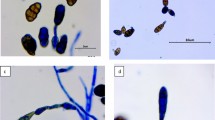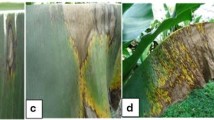Abstract
A black spot disease on cultivated alstroemeria was found in Nagano Prefecture, Japan, in January 2008. The causal fungus isolated from the diseased plants was morphologically identified as Alternaria alstroemeriae E.G. Simmons & C.F. Hill. An inoculation test with the isolated fungus demonstrated that the disease is caused by this species. This is the first report of black spot on alstroemeria (kokuhan-byo, in Japanese) caused by A. alstroemeriae in Japan.
Similar content being viewed by others
Avoid common mistakes on your manuscript.
Introduction
Alstroemeria (Alstroemeria sp.; Alstroemeriaceae) is a perennial, ornamental plant native to South America and is becoming very popular as a cut flower in Japan. Several diseases of alstroemeria, such as gray mold (Horita 1994) and various viral diseases (Fukumoto et al. 2005) have been found in Nagano Prefecture, where the most alstroemeria in Japan are produced. However, in January 2008, a previously unknown fungal disease was found on greenhouse plants in the city of Matsumoto, Nagano Prefecture. The purpose of this study was to identify the fungus causing this disease and to confirm its pathogenicity. Parts of this study were presented previously (Yamagishi et al. 2009).
Symptoms
Natural symptoms were observed on leaves of alstroemeria at the flowering stage. Early symptoms appeared as small, dark-brownish spots on leaves. Subsequently, the spots (spindle to irregular shaped) enlarged into black lesions (Fig. 1a). At an advanced stage, the same spots also appeared on stems of severely infected plants. The symptoms first occurred near the curtain, and spread to surrounding areas. Conditions near the curtain were humid from condensation.
Symptoms of black spot of alstroemeria and morphology of the causal fungus, Alternaria alstroemeriae. a Black spots on leaves on naturally infected alstroemeria in a greenhouse. b Leaf spot 10 days after inoculation with conidia of the fungus. c Conidia formed on potato carrot agar (PCA). Bar 25 μm. d. Subcylindrical, mature conidium, a distinctive feature of the species on PCA. Bar 25 μm. e Sporulation submerged within PCA agar. Bar 25 μm. f Conidiophores formed on PCA. Bar 25 μm. g Colonies of A. alstroemeriae on potato dextrose agar (PDA) after 7 days incubation at 25°C in the dark (left surface; right reverse)
Isolation and identification of the pathogen
Surface-sterilized lesion tissues from leaves were placed on 1.5% agar plates containing 0.03% streptomycin and incubated at 25°C. A monoconidial isolate was obtained from these cultures, and this isolate was cultured on potato carrot agar (PCA; 2% agar in infused 2% carrot and 2% potato water) for identification. Conidia are produced on the PCA surface in short chains of 2–5, maximum 8, on short, generally simple conidiophores that are 3.0–32.0 × 3.0–5.5 μm in size (Fig. 1f). Lateral branches are rarely present after 5–7 days of culture. Conidia are brown to dark brown, ovoid, obclavate to subcylindrical, 7.0–62.5 × 5.0–18.0 μm in size, with 0–8 transverse septa and 0–3 longitudinal septa (Fig. 1c, d). The conidial surface is often rough. Secondary conidiophores are usually short, with 1–2 cells. Sporulation is also abundant on the agar substrate (Fig. 1e). Conidia that develop within the substrate are ovoid or ellipsoid, and generally smaller than surface conidia, from 7.5–28.5 × 3.0–8.0 μm including secondary conidiophores, with 0–6 transverse septa and no longitudinal septa. These morphological characteristics of our isolate were identical to a previously published description (Simmons 2007) of Alternaria alstroemeriae E.G. Simmons & C.F. Hill (Table 1).
A. alstroemeriae is unique among the genus Alternaria in having the following features: (1) conidia in short chains (never exceed 10), (2) subcylindrical conidia produced in basal parts of a conidial chain, (3) sporulation submerged in agar substrates (Simmons 2007), because our isolate has all these distinctive features of the species (Table 1, Fig. 1c–e), we identified our isolate as A. alstroemeriae. The optimum temperature for mycelial growth on PDA (potato dextrose agar, Nissui, Tokyo, Japan) are olivaceous brown to black (Fig. 1g), with sparse aerial mycelium. The optimum temperature for mycelial growth on PDA is 25–30°C (Yamagishi et al. 2009). Alstroemeria plants are the only known host of the species (Simmons 2007).
Pathogenicity
The isolate was tested for pathogenicity on leaves of alstroemeria cultivated in a greenhouse. Conidia formed on PDA were suspended in sterilized distilled water at a density of 104 conidia/ml, and sprayed on potted, healthy alstroemeria plants. Sterilized water was sprayed on several healthy plants as a negative control. All plants were incubated in a greenhouse under humid conditions for 10 days. Typical symptoms appeared on the leaves of all inoculated plants (Fig. 1b), but no symptoms were observed on control plants. The inoculated fungus was consistently re-isolated from the diseased leaves, demonstrating that the isolate is pathogenic to alstroemeria. This is first report of a disease caused by A. alstroemeriae in Japan, and we propose naming this novel disease black spot of alstroemeria (Kokuhan-byo in Japanese). The isolate has been deposited in the National Institute of Agrobiological Science Gene bank as MAFF-241374.
References
Fukumoto F, Fuji S, Fujinaga M, Ikeda M, Shinoda K, Uematsu S, Maoka T, Hayano Y (2005) Incidence of viruses infecting alstroemeria plants and characterization of Cucumber mosaic and Alstromeria mosaic viruses (abstract in Japanese). Jpn J Phytopathol 71:234–235
Horita H (1994) Gray mold disease of various flower crops caused by Botrytis spp. in Hokkaido (abstract in Japanese). Jpn J Phytopathol 60:792
Simmons EG (2007) Alternaria, an identification manual. CBS Biodiversity series 6, Netherlands, pp 444-445
Yamagishi N, Nishikawa J, Oshima Y, Eguchi N, Takeda K (2009) Black spot on alstroemeria caused by Alternaria alstroemeriae E.G. Simmons & C.F. Hill new to Japan (abstract in Japanese). Jpn J Phytopathol 75:71
Acknowledgments
We sincerely thank Dr. C. Nakajima (Mie University) for support during this study. We also thank Mr. K. Kamiya (Nanshin Agricultural Experiment Station) for supplying healthy alstroemeria plants.
Author information
Authors and Affiliations
Corresponding author
Rights and permissions
About this article
Cite this article
Yamagishi, N., Nishikawa, J., Oshima, Y. et al. Black spot disease of alstroemeria caused by Alternaria alstroemeriae in Japan. J Gen Plant Pathol 75, 401–403 (2009). https://doi.org/10.1007/s10327-009-0182-0
Received:
Accepted:
Published:
Issue Date:
DOI: https://doi.org/10.1007/s10327-009-0182-0





